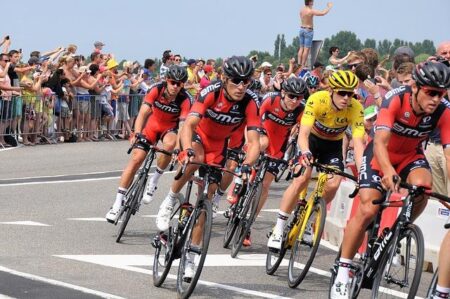In the ever-evolving world of professional cycling, advancements in technology, materials, and training methodologies have dramatically transformed the sport over the past decade. As elite athletes continue to push the boundaries of performance, a provocative question arises: would Tadej Poga─ıar, the Slovenian cycling sensation and two-time Tour de France champion, still dominate the peloton if he were racing on a bike from ten years ago? In a recent interview, Team Ineos Grenadiers rider Luke Rowe unequivocally dismissed this notion, stating, “No chance.” Rowe’s remarks highlight the critical role of equipment in modern cycling and set the stage for a deeper exploration into how the sport’s technological advancements have reshaped competitive dynamics. This article delves into the implications of Rowe’s assertion and examines whether the bike or the rider truly makes the difference in today’s high-stakes races.
Pioneering Technology: How Modern Bikes Enhance Performance in Competitive Cycling
Modern cycling technology has dramatically evolved over the past decade, leading to significant enhancements in bike performance that greatly influence competitive racing outcomes. Innovations such as aerodynamic frame designs, lighter materials, and advanced gearing systems allow cyclists to achieve faster speeds with less effort. For example, contemporary road bikes often feature carbon fiber construction, which reduces weight while remaining incredibly stiff, translating to more efficient power transfer during sprints. Additionally, the integration of electronic shifting systems has revolutionized gear changes, making them smoother and quicker, ensuring that riders can maintain optimal cadence even in critical racing moments.
Key components contributing to performance improvement in modern bikes include:
- Disc Brakes: Offering better modulation and stopping power in varied conditions.
- Integrated Cockpits: Enhancing aerodynamics by minimizing drag.
- Smart Technology: Data collection for performance tracking during rides.
To illustrate the difference between bikes from a decade ago and today’s models, consider the following comparison:
| Feature | 10 Years Ago | Modern Bikes |
|---|---|---|
| Materials | Aluminum & Basic Carbon Fiber | Advanced Carbon Fiber & Titanium Alloys |
| Braking System | Caliper Brakes | Hydraulic Disc Brakes |
| Shifting Mechanism | Mechanical Shift | Electronic Shift |
This leap in technology not only influences individual performance but also alters the dynamics of competitive cycling as a whole. As Luke Rowe noted, the advancements in bike technology make a historical comparison to today’s champions like Tadej Poga─ıar almost unfair; without the benefits of cutting-edge design and engineering, past cyclists would struggle to keep pace.
Expert Opinions Unveiled: Luke Rowe Discusses the Impact of Equipment on Racing Outcomes
In a recent discussion, Luke Rowe, the experienced rider and team leader, shared his insights on the critical role that modern equipment plays in professional cycling. According to Rowe, advancements in bicycle technology over the past decade have fundamentally reshaped racing dynamics. He argued that contemporary bikes, designed with high-grade materials and precision engineering, enhance aerodynamics, weight distribution, and overall performance, creating a tangible gap between equipment from ten years ago and today’s standards. Rowe emphasized that without the benefits of advancements, even a rider of Tadej Poga─ıar’s caliber would struggle to secure victories on older models.
Rowe highlighted several key factors that contribute to the enhanced performance of modern bicycles:
- Aerodynamics: Streamlined frames reduce drag, allowing riders to maintain higher speeds with less effort.
- Weight: Advances in materials have led to lighter bikes, improving climbing efficiency and maneuverability.
- Stability: Improved handling characteristics provide riders with better control, especially in technical descents.
- Gear Technology: Enhanced gear systems facilitate quicker, more precise shifting, essential for competitive racing.
Rowe’s assertion that Poga─ıar wouldn’t stand a chance on a decade-old bike raises an important conversation about the evolution of the sport. To emphasize this point, consider the following comparison:
| Feature | 10 Years Ago | Today |
|---|---|---|
| Aerodynamic Design | Basic shapes with limited wind tunnel testing | Advanced CAD and extensive wind tunnel optimization |
| Frame Material | Alloy and early carbon models | High-modulus carbon fiber and lightweight composites |
| Gear Systems | Mechanical shifting | Electronic systems with precise calibration |
Historical Comparisons: The Evolution of Cycling Gear and Its Role in Athletic Success
The evolution of cycling gear over the past decade has been nothing short of revolutionary. Innovations in materials, technology, and design have dramatically altered the landscape of competitive cycling. Compared to bikes from just ten years ago, contemporary models are significantly lighter, more aerodynamic, and equipped with advanced shifting systems that offer greater precision and responsiveness. As Luke Rowe emphatically states, a modern athlete like Tadej Poga─ıar, who relies on an intricate set of components that enhance both performance and comfort, would struggle immensely to replicate his successes on a bike from a decade past. The brisk pace of innovation has fundamentally changed the game, making it essential for riders to embrace the latest advancements.
When examining the differences in cycling gear, key factors must be considered to understand how they contribute to athletic success. Some of these include:
- Frame materials: Modern bikes utilize carbon fiber and advanced alloys that provide an optimal balance of strength and weight.
- Aerodynamics: Streamlined designs reduce drag, allowing riders to maintain higher speeds with less effort.
- Technology: Integrated electronic shifting systems deliver precise gear changes, enabling better response during critical moments of a race.
- Tire technology: Improved tire compounds and designs enhance grip and rolling efficiency on varying terrains.
To further illustrate the impact of these advancements, we can examine a comparison of select bike specifications over the years:
| Feature | 2013 Model | 2023 Model |
|---|---|---|
| Weight | 8.5 kg | 6.8 kg |
| Gear System | Mechanical 10-speed | Electronic 12-speed |
| Frame Material | Aluminum | Carbon Fiber |
| Aerodynamic Design | Standard | Advanced |
This dramatic evolution not only highlights the technological advancements in cycling gear but also exemplifies how they directly correlate to athletic performance. As cycling continues to evolve, the gap between the capabilities of past and present equipment will only widen, reinforcing Rowe’s assertion regarding the immense challenges any contemporary rider would face on outdated gear.
In Summary
In conclusion, the debate over whether Tadej Poga─ıar could replicate his extraordinary performances on a bike from a decade ago has sparked considerable discourse among cycling enthusiasts and professionals alike. Luke Rowe’s emphatic assertion that there is “no chance” of such a feat underscores the significant advancements in technology and training methodologies that have reshaped the sport. The evolution of equipment, aerodynamics, and rider conditioning plays a pivotal role in contemporary cycling, suggesting that today’s athletes are not merely competing against one another, but also against the past standards of their sport. As discussions continue, one thing remains clear: while Poga─ıar’s prowess is undeniable, the tools of the trade have evolved in ways that could fundamentally challenge historical comparisons. The intersections of technology, athlete performance, and the ever-changing landscape of professional cycling will continue to fuel speculation and analysis as we look ahead to the next generation of cyclists.











